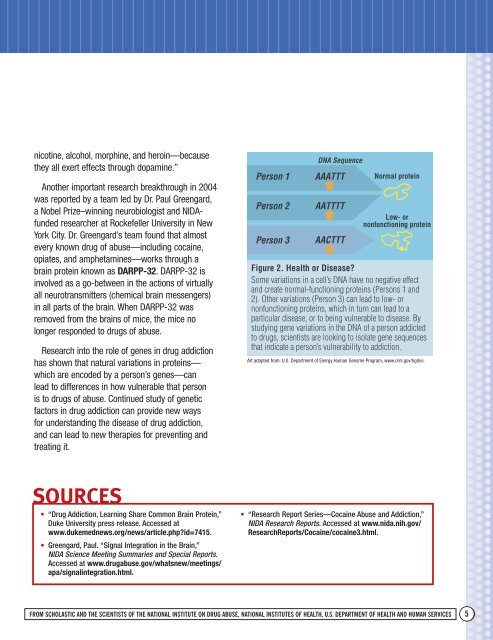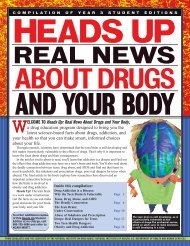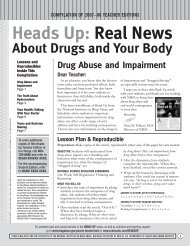Heads Up: Real News - Scholastic
Heads Up: Real News - Scholastic
Heads Up: Real News - Scholastic
You also want an ePaper? Increase the reach of your titles
YUMPU automatically turns print PDFs into web optimized ePapers that Google loves.
nicotine, alcohol, morphine, and heroin—because<br />
they all exert effects through dopamine.”<br />
Another important research breakthrough in 2004<br />
was reported by a team led by Dr. Paul Greengard,<br />
a Nobel Prize–winning neurobiologist and NIDAfunded<br />
researcher at Rockefeller University in New<br />
York City. Dr. Greengard’s team found that almost<br />
every known drug of abuse—including cocaine,<br />
opiates, and amphetamines—works through a<br />
brain protein known as DARPP-32. DARPP-32 is<br />
involved as a go-between in the actions of virtually<br />
all neurotransmitters (chemical brain messengers)<br />
in all parts of the brain. When DARPP-32 was<br />
removed from the brains of mice, the mice no<br />
longer responded to drugs of abuse.<br />
Research into the role of genes in drug addiction<br />
has shown that natural variations in proteins—<br />
which are encoded by a person’s genes—can<br />
lead to differences in how vulnerable that person<br />
is to drugs of abuse. Continued study of genetic<br />
factors in drug addiction can provide new ways<br />
for understanding the disease of drug addiction,<br />
and can lead to new therapies for preventing and<br />
treating it.<br />
Person 1<br />
Person 2<br />
Person 3<br />
DNA Sequence<br />
AAATTT<br />
AATTTT<br />
AACTTT<br />
Normal protein<br />
Low- or<br />
nonfunctioning protein<br />
Figure 2. Health or Disease<br />
Some variations in a cell’s DNA have no negative effect<br />
and create normal-functioning proteins (Persons 1 and<br />
2). Other variations (Person 3) can lead to low- or<br />
nonfunctioning proteins, which in turn can lead to a<br />
particular disease, or to being vulnerable to disease. By<br />
studying gene variations in the DNA of a person addicted<br />
to drugs, scientists are looking to isolate gene sequences<br />
that indicate a person’s vulnerability to addiction.<br />
Art adapted from: U.S. Department of Energy Human Genome Program, www.ornl.gov/hgmis.<br />
SOURCES<br />
• “Drug Addiction, Learning Share Common Brain Protein,”<br />
Duke University press release. Accessed at<br />
www.dukemednews.org/news/article.phpid=7415.<br />
• Greengard, Paul. “Signal Integration in the Brain,”<br />
NIDA Science Meeting Summaries and Special Reports.<br />
Accessed at www.drugabuse.gov/whatsnew/meetings/<br />
apa/signalintegration.html.<br />
• “Research Report Series—Cocaine Abuse and Addiction,”<br />
NIDA Research Reports. Accessed at www.nida.nih.gov/<br />
ResearchReports/Cocaine/cocaine3.html.<br />
FROM SCHOLASTIC AND THE SCIENTISTS OF THE NATIONAL INSTITUTE ON DRUG ABUSE, NATIONAL INSTITUTES OF HEALTH, U.S. DEPARTMENT OF HEALTH AND HUMAN SERVICES<br />
5









